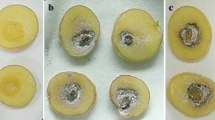Abstract
In this work the actin gene was used to establish phylogenetic relationships of wider and more diffuse species of the genus Saccharomyces in food ecology by temporal temperature gradient electrophoresis (TTGE) and amplified restriction fragment length polymorphism (RFLP) analysis. Results for DNA RFLP analysis varied considerably, and some enzymes showed a high intra- and interspecific power; however, comparison of experimental results with those provided by the National Center for Biotechnology Information database disclosed a number of interesting variations. Only some experimental results matched the theoretical ones. A theoretical study of melting temperatures using available information from partial sequences of the actin gene was done. Several Saccharomyces species and strains could be distinguished using different TTGE melting points. Some degree of discrimination was achieved under different conditions, in that the Saccharomyces strains tested were separated into groups like the results obtained by PCR-RFLP.




Similar content being viewed by others
References
Barnett JA, Payne RW, Yarrow D (2000) Yeasts: characteristics and identification, 3rd edn. Cambridge University Press, Cambridge
Belmont LD, Drubin DG (2001) Actin structure function relationships revealed by yeast molecular genetics. Results Probl Cell Differ 32:103–121
Briones A, Úbeda J, Grando S (1996) Differentiation of Saccharomyces cerevisiae strains isolated from fermenting must according to their karyotype patterns. Int J Food Microbiol 28:369–377
Fernández-Espinar MT, Esteve-Zarzoso B, Querol A, Barrio E (2000) RFLP analysis of the ribosomal internal transcribed spacers and the 5.8S rRNA gene region of the genus Saccharomyces: a fast method for species identification and the differentiation of flor yeasts. Ant van Leeuwen 78:87–97
Fernández-González M, Espinosa JC, Úbeda JF, Briones AI (2001) Yeasts present during wine fermentation:comparative analysis of conventional plating and PCR-TTGE. Syst Appl Microbiol 24:634–638
Guillamón JM, Sabaté J, Barrio E, Cano J, Querol A (1998) Rapid identification of wine yeast species based on RFLP analysis of the ribosomal ITS region. Arch Microbiol 169:387–392
Hernán-Gómez S, Espinosa JC, Úbeda JF (2000) Characterization of wine yeast by temperature gradient gel electrophoresis (TGGE). FEMS Microbiol Lett 193:45–50
James SA, Cai J, Roberts N, Collins MO (1997) A phylogenetic analysis of the genus Saccharomyces based on 18S rRNA gene secuences: descripcion of Saccharomyces kunashirensis sp. nov. and Saccharomyces martiniae sp. Int J Syst Bacteriol 47:453–460
Josepa S, Guillamón JM, Cano J (2000) PCR differentiation of Saccharomyces cerevisiae from Saccharomyces bayanus/Saccharomyces pastorianus using specific primers. FEMS Microbiol Lett 193:255–259
Manzano M, Cocolin L, Lacumin L, Cantoni C, Comi G (2005) A PCR-TGGE technique to assess differentiation among enological Saccharomyces cerevisiae strains. Int J Food Microbiol 101:333–339
Manzano M, Medrala D, Giusto C, Bartolomeoli I, Urso R, Comi G (2006) Classical and molecular analyses to characterize commercial dry yeasts used in wine fermentations. J Appl Microbiol 100:599–607
Muyzer G, Somalla K (1998) Application of denaturing gradient electrophoresis (DGGE) and temperature gradient gel electrophoresis (TGGE) in microbial ecology. Ant van Leeuwen 73:127–141
Nügel R, Abelson J (1980) Isolation and sequence of the gene for actin in Saccharomyces cerevisiae. Proc Natl Acad Sci USA 77:3912–3916
Querol A, Barrio E, Ramón D (1992) A comparative study of different methods of yeast strain characterization. Syst Appl Microbiol 15:439–446
Rose MD, Winston F, Ph Hieter (1990) Methods in yeast genetics: a laboratory course manual. Cold Spring Harbor Laboratory Press, Cold Spring Harbor, NY, pp 131–132
Smole-Mozina S, Dlauchy D, Deak T, Raspor P (1997) Identification of Saccharomyces sensu stricto and Torulaspora yeast by PCR ribotyping. Lett Appl Microbiol 24:311–315
Tominaga T (2004) Rapid identification of pickle yeasts by fluorescent PCR and microtemperature-gradient gel electrophoresis. FEMS Microbiol Lett 238:43–48
Torriani S, Zapparoli G, Suzzi G (1999) Genetic and phenotypic diversity of Saccharomyces sensu stricto strains isolates from Amarone wine. Diversity of Saccharomyces strains from Amarone wine. Ant van Leeuwen 75:207–215
Acknowledgment
The authors are grateful to the Regional Government (JJCCM) for the funds assigned to Project PCI 08-0095-8912.
Author information
Authors and Affiliations
Corresponding author
Rights and permissions
About this article
Cite this article
Úbeda, J.F., Fernández-González, M. & Briones, A.I. Application of PCR-TTGE and PCR-RFLP for Intraspecific and Interspecific Characterization of the Genus Saccharomyces Using Actin Gene (ACT1) Primers. Curr Microbiol 58, 58–63 (2009). https://doi.org/10.1007/s00284-008-9283-9
Received:
Accepted:
Published:
Issue Date:
DOI: https://doi.org/10.1007/s00284-008-9283-9




